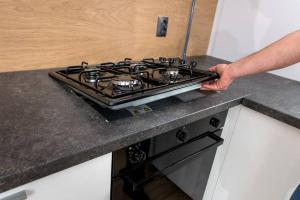Ultimate Guide to Installing a Cooktop: Step-by-Step Instructions

-
Quick Links:
- Introduction
- Types of Cooktops
- Tools and Materials Needed
- Pre-Installation Steps
- Installation Process
- Post-Installation Tips
- Safety Considerations
- Common Issues During Installation
- Case Studies
- Expert Insights
- FAQs
Introduction
Installing a cooktop can seem daunting, but with the right knowledge and tools, you can tackle this project yourself. Whether you're upgrading your kitchen or replacing an old appliance, understanding the installation process is crucial. This guide provides comprehensive steps and insights to ensure a successful cooktop installation.
Types of Cooktops
Before diving into the installation process, it's essential to understand the different types of cooktops available:
- Electric Cooktops: These cooktops use electric coils or induction technology.
- Gas Cooktops: These operate using natural gas or propane.
- Downdraft Cooktops: These come with built-in ventilation systems.
- Modular Cooktops: These allow customization with various cooking modules such as grills, griddles, and burners.
Tools and Materials Needed
Gather the following tools and materials to ensure a smooth installation process:
- Level
- Screwdriver (Phillips and flathead)
- Socket wrench set
- Pliers
- Measuring tape
- Electrical tape
- Wire nuts
- Cooktop installation kit (if applicable)
- Safety goggles
- Gloves
Pre-Installation Steps
- Read the Manufacturer’s Manual: Always start by reviewing the installation manual provided by the manufacturer.
- Measure the Cutout: Ensure the cutout in your countertop meets the dimensions specified by the cooktop manufacturer.
- Check Electrical or Gas Supply: Verify that the necessary connections are available and comply with local codes.
- Prepare the Workspace: Clear the area and ensure you have enough space to work safely.
Installation Process
Electric Cooktop Installation
Follow these steps for installing an electric cooktop:
- Turn Off Power: Ensure the power to the cooktop circuit is turned off at the circuit breaker.
- Connect Wiring: Attach the cooktop's wiring to the existing electrical supply using wire nuts. Ensure to match colors (typically black to black, white to white, and green or bare copper for ground).
- Secure the Cooktop: Place the cooktop into the countertop cutout and secure it as per the manufacturer’s instructions.
- Test the Installation: Turn on the power and test each burner to ensure proper functionality.
Gas Cooktop Installation
For gas cooktops, follow these steps:
- Turn Off Gas Supply: Ensure the gas supply is turned off before starting the installation.
- Connect Gas Line: Use a flexible gas line to connect the cooktop to the gas supply. Ensure connections are tight and leak-free.
- Secure the Cooktop: Like with electric cooktops, place the cooktop into the countertop cutout and secure it.
- Test for Leaks: Use a soap solution to check for gas leaks around connections. If bubbles form, tighten connections.
- Test the Installation: Turn on the gas supply and ignite the burners to ensure proper operation.
Post-Installation Tips
After successfully installing your cooktop, consider the following:
- Keep the area around the cooktop clean and free of flammable materials.
- Regularly check connections for gas or electrical issues.
- Refer to the user manual for maintenance and troubleshooting tips.
Safety Considerations
Safety should always be a priority during installation:
- Always wear safety goggles and gloves while working.
- Make sure to turn off all power and gas supplies before beginning the installation.
- If you are uncomfortable with gas or electrical work, consider hiring a professional.
Common Issues During Installation
Be aware of these common issues that may arise during installation:
- Improper fit in the countertop cutout.
- Electrical connection issues leading to malfunction.
- Gas leaks due to loose connections.
- Uneven cooktop placement affecting cooking performance.
Case Studies
Through various case studies, we can learn from others' experiences:
Case Study 1: Electric Cooktop Installation
A homeowner attempted to install an electric cooktop without proper measurements, resulting in a poor fit. They later realized the importance of precise cutout measurements.
Case Study 2: Gas Cooktop Leak
Another homeowner faced a gas leak due to improper connections. After consulting a professional, they learned the significance of using a soap solution to check for leaks post-installation.
Expert Insights
According to industry experts, proper preparation and knowledge of local codes are essential for a successful cooktop installation. They recommend consulting with professionals for electrical and gas connections to ensure safety and compliance.
FAQs
1. Can I install a cooktop myself?
Yes, if you have the right tools and knowledge, you can install a cooktop yourself. However, for gas connections, it's advisable to hire a professional.
2. How do I know what size cooktop to buy?
Measure the cutout in your countertop and consult the cooktop specifications to ensure a proper fit.
3. What tools will I need for installation?
You will need a level, screwdrivers, a socket wrench set, pliers, measuring tape, electrical tape, and safety gear.
4. How do I check for gas leaks after installation?
Use a soap solution on the connections; if bubbles form, there is a leak that needs to be addressed.
5. What should I do if my cooktop doesn’t heat properly?
Check your electrical connections or gas supply. If issues persist, consult the manufacturer’s manual or a professional.
6. Can I convert a gas cooktop to electric?
Yes, but it requires significant alterations to your kitchen's electrical system and should be done by a professional.
7. How often should I clean my cooktop?
Clean your cooktop after each use to prevent residue buildup and maintain its appearance.
8. What are the benefits of induction cooktops?
Induction cooktops are energy-efficient, heat quickly, and provide precise cooking control.
9. Is it safe to install a cooktop near a window?
While it's generally safe, ensure that the window can be securely closed to prevent drafts and heat loss.
10. What are the local codes for cooktop installation?
Local codes vary; it’s essential to check with your local building department for specific requirements.